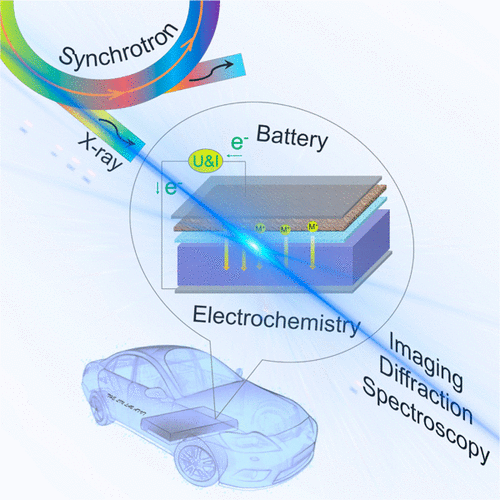当前位置:
X-MOL 学术
›
Chem. Rev.
›
论文详情
Our official English website, www.x-mol.net, welcomes your feedback! (Note: you will need to create a separate account there.)
Synchrotron X-ray Analytical Techniques for Studying Materials Electrochemistry in Rechargeable Batteries
Chemical Reviews ( IF 62.1 ) Pub Date : 2017-09-29 00:00:00 , DOI: 10.1021/acs.chemrev.7b00007 Feng Lin 1 , Yijin Liu 2 , Xiqian Yu 3, 4 , Lei Cheng 5 , Andrej Singer 6 , Oleg G. Shpyrko 6 , Huolin L. Xin 7 , Nobumichi Tamura 8 , Chixia Tian 5 , Tsu-Chien Weng 9 , Xiao-Qing Yang 3 , Ying Shirley Meng 10 , Dennis Nordlund 2 , Wanli Yang 8 , Marca M. Doeff 5
Chemical Reviews ( IF 62.1 ) Pub Date : 2017-09-29 00:00:00 , DOI: 10.1021/acs.chemrev.7b00007 Feng Lin 1 , Yijin Liu 2 , Xiqian Yu 3, 4 , Lei Cheng 5 , Andrej Singer 6 , Oleg G. Shpyrko 6 , Huolin L. Xin 7 , Nobumichi Tamura 8 , Chixia Tian 5 , Tsu-Chien Weng 9 , Xiao-Qing Yang 3 , Ying Shirley Meng 10 , Dennis Nordlund 2 , Wanli Yang 8 , Marca M. Doeff 5
Affiliation

|
Rechargeable battery technologies have ignited major breakthroughs in contemporary society, including but not limited to revolutions in transportation, electronics, and grid energy storage. The remarkable development of rechargeable batteries is largely attributed to in-depth efforts to improve battery electrode and electrolyte materials. There are, however, still intimidating challenges of lower cost, longer cycle and calendar life, higher energy density, and better safety for large scale energy storage and vehicular applications. Further progress with rechargeable batteries may require new chemistries (lithium ion batteries and beyond) and better understanding of materials electrochemistry in the various battery technologies. In the past decade, advancement of battery materials has been complemented by new analytical techniques that are capable of probing battery chemistries at various length and time scales. Synchrotron X-ray techniques stand out as one of the most effective methods that allow for nearly nondestructive probing of materials characteristics such as electronic and geometric structures with various depth sensitivities through spectroscopy, scattering, and imaging capabilities. This article begins with the discussion of various rechargeable batteries and associated important scientific questions in the field, followed by a review of synchrotron X-ray based analytical tools (scattering, spectroscopy, and imaging) and their successful applications (ex situ, in situ, and in operando) in gaining fundamental insights into these scientific questions. Furthermore, electron microscopy and spectroscopy complement the detection length scales of synchrotron X-ray tools and are also discussed toward the end. We highlight the importance of studying battery materials by combining analytical techniques with complementary length sensitivities, such as the combination of X-ray absorption spectroscopy and electron spectroscopy with spatial resolution, because a sole technique may lead to biased and inaccurate conclusions. We then discuss the current progress of experimental design for synchrotron experiments and methods to mitigate beam effects. Finally, a perspective is provided to elaborate how synchrotron techniques can impact the development of next-generation battery chemistries.
中文翻译:

用于可充电电池材料电化学的同步加速器X射线分析技术
可充电电池技术已点燃了当代社会的重大突破,包括但不限于交通,电子和电网储能的革命。可充电电池的显着发展很大程度上归功于为改善电池电极和电解质材料而进行的深入努力。然而,对于大规模储能和车辆应用而言,仍然存在着较低的成本,更长的循环寿命和日历寿命,更高的能量密度以及更好的安全性等令人生畏的挑战。充电电池的进一步发展可能需要新的化学方法(锂离子电池及其他),并需要更好地了解各种电池技术中的材料电化学。在过去的十年中,电池材料的进步已经得到了新的分析技术的补充,这些技术能够在各种长度和时间范围内探测电池的化学性质。同步加速器X射线技术是最有效的方法之一,可通过光谱学,散射和成像功能对材料特性(例如具有各种深度灵敏度的电子和几何结构)进行几乎无损探测。本文首先讨论该领域中的各种可充电电池和相关的重要科学问题,然后回顾基于同步加速器X射线的分析工具(散射,光谱和成像)及其成功应用(非现场,现场,以及在操作上),以获取对这些科学问题的基本见解。此外,电子显微镜和光谱学对同步加速器X射线工具的检测长度范围进行了补充,并在最后进行了讨论。我们强调通过将分析技术与互补的长度敏感性(例如X射线吸收光谱法和电子光谱法与空间分辨率相结合)相结合来研究电池材料的重要性,因为唯一的技术可能会导致有偏见和不准确的结论。然后,我们讨论用于同步加速器实验的实验设计的当前进展以及减轻光束影响的方法。最后,提供了一个角度来阐述同步加速器技术如何影响下一代电池化学的发展。我们强调通过将分析技术与互补的长度敏感性(例如X射线吸收光谱法和电子光谱法与空间分辨率相结合)相结合来研究电池材料的重要性,因为唯一的技术可能会导致有偏见和不准确的结论。然后,我们讨论用于同步加速器实验的实验设计的当前进展以及减轻光束影响的方法。最后,提供了一个角度来阐述同步加速器技术如何影响下一代电池化学的发展。我们强调通过将分析技术与互补的长度敏感性(例如X射线吸收光谱法和电子光谱法与空间分辨率相结合)相结合来研究电池材料的重要性,因为唯一的技术可能会导致有偏见和不准确的结论。然后,我们讨论用于同步加速器实验的实验设计的当前进展以及减轻光束影响的方法。最后,提供了一个角度来阐述同步加速器技术如何影响下一代电池化学的发展。因为唯一的技术可能导致有偏见和不正确的结论。然后,我们讨论用于同步加速器实验的实验设计的当前进展以及减轻光束影响的方法。最后,提供了一个角度来阐述同步加速器技术如何影响下一代电池化学的发展。因为唯一的技术可能导致有偏见和不准确的结论。然后,我们讨论用于同步加速器实验的实验设计的当前进展以及减轻光束影响的方法。最后,提供了一个角度来阐述同步加速器技术如何影响下一代电池化学的发展。
更新日期:2017-09-29
中文翻译:

用于可充电电池材料电化学的同步加速器X射线分析技术
可充电电池技术已点燃了当代社会的重大突破,包括但不限于交通,电子和电网储能的革命。可充电电池的显着发展很大程度上归功于为改善电池电极和电解质材料而进行的深入努力。然而,对于大规模储能和车辆应用而言,仍然存在着较低的成本,更长的循环寿命和日历寿命,更高的能量密度以及更好的安全性等令人生畏的挑战。充电电池的进一步发展可能需要新的化学方法(锂离子电池及其他),并需要更好地了解各种电池技术中的材料电化学。在过去的十年中,电池材料的进步已经得到了新的分析技术的补充,这些技术能够在各种长度和时间范围内探测电池的化学性质。同步加速器X射线技术是最有效的方法之一,可通过光谱学,散射和成像功能对材料特性(例如具有各种深度灵敏度的电子和几何结构)进行几乎无损探测。本文首先讨论该领域中的各种可充电电池和相关的重要科学问题,然后回顾基于同步加速器X射线的分析工具(散射,光谱和成像)及其成功应用(非现场,现场,以及在操作上),以获取对这些科学问题的基本见解。此外,电子显微镜和光谱学对同步加速器X射线工具的检测长度范围进行了补充,并在最后进行了讨论。我们强调通过将分析技术与互补的长度敏感性(例如X射线吸收光谱法和电子光谱法与空间分辨率相结合)相结合来研究电池材料的重要性,因为唯一的技术可能会导致有偏见和不准确的结论。然后,我们讨论用于同步加速器实验的实验设计的当前进展以及减轻光束影响的方法。最后,提供了一个角度来阐述同步加速器技术如何影响下一代电池化学的发展。我们强调通过将分析技术与互补的长度敏感性(例如X射线吸收光谱法和电子光谱法与空间分辨率相结合)相结合来研究电池材料的重要性,因为唯一的技术可能会导致有偏见和不准确的结论。然后,我们讨论用于同步加速器实验的实验设计的当前进展以及减轻光束影响的方法。最后,提供了一个角度来阐述同步加速器技术如何影响下一代电池化学的发展。我们强调通过将分析技术与互补的长度敏感性(例如X射线吸收光谱法和电子光谱法与空间分辨率相结合)相结合来研究电池材料的重要性,因为唯一的技术可能会导致有偏见和不准确的结论。然后,我们讨论用于同步加速器实验的实验设计的当前进展以及减轻光束影响的方法。最后,提供了一个角度来阐述同步加速器技术如何影响下一代电池化学的发展。因为唯一的技术可能导致有偏见和不正确的结论。然后,我们讨论用于同步加速器实验的实验设计的当前进展以及减轻光束影响的方法。最后,提供了一个角度来阐述同步加速器技术如何影响下一代电池化学的发展。因为唯一的技术可能导致有偏见和不准确的结论。然后,我们讨论用于同步加速器实验的实验设计的当前进展以及减轻光束影响的方法。最后,提供了一个角度来阐述同步加速器技术如何影响下一代电池化学的发展。



























 京公网安备 11010802027423号
京公网安备 11010802027423号